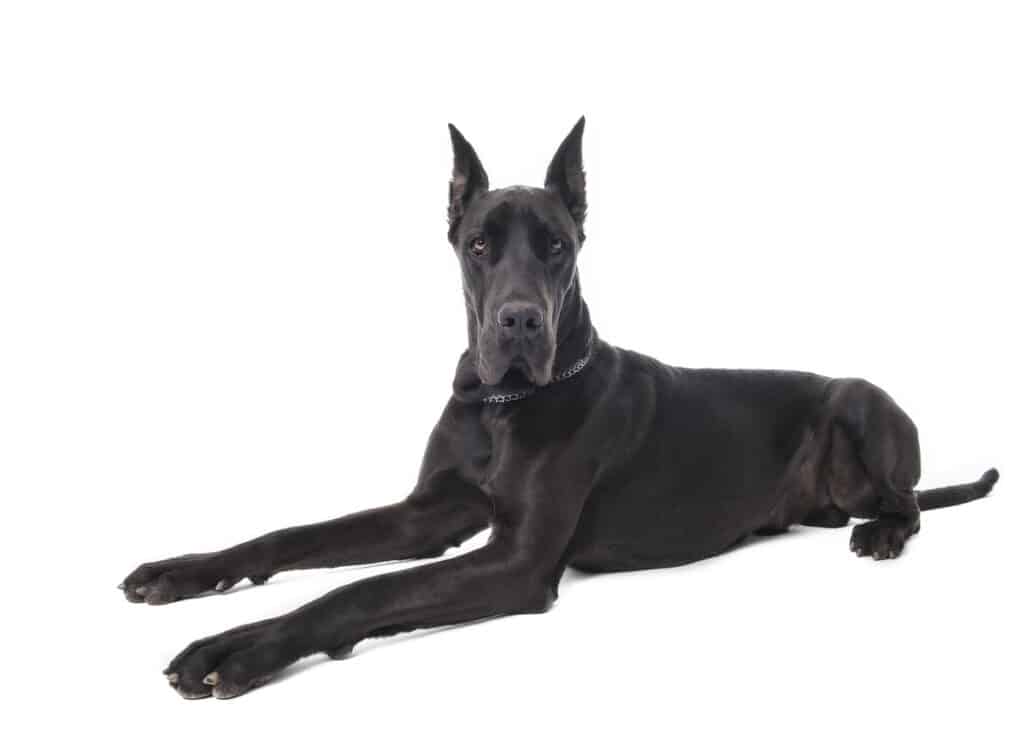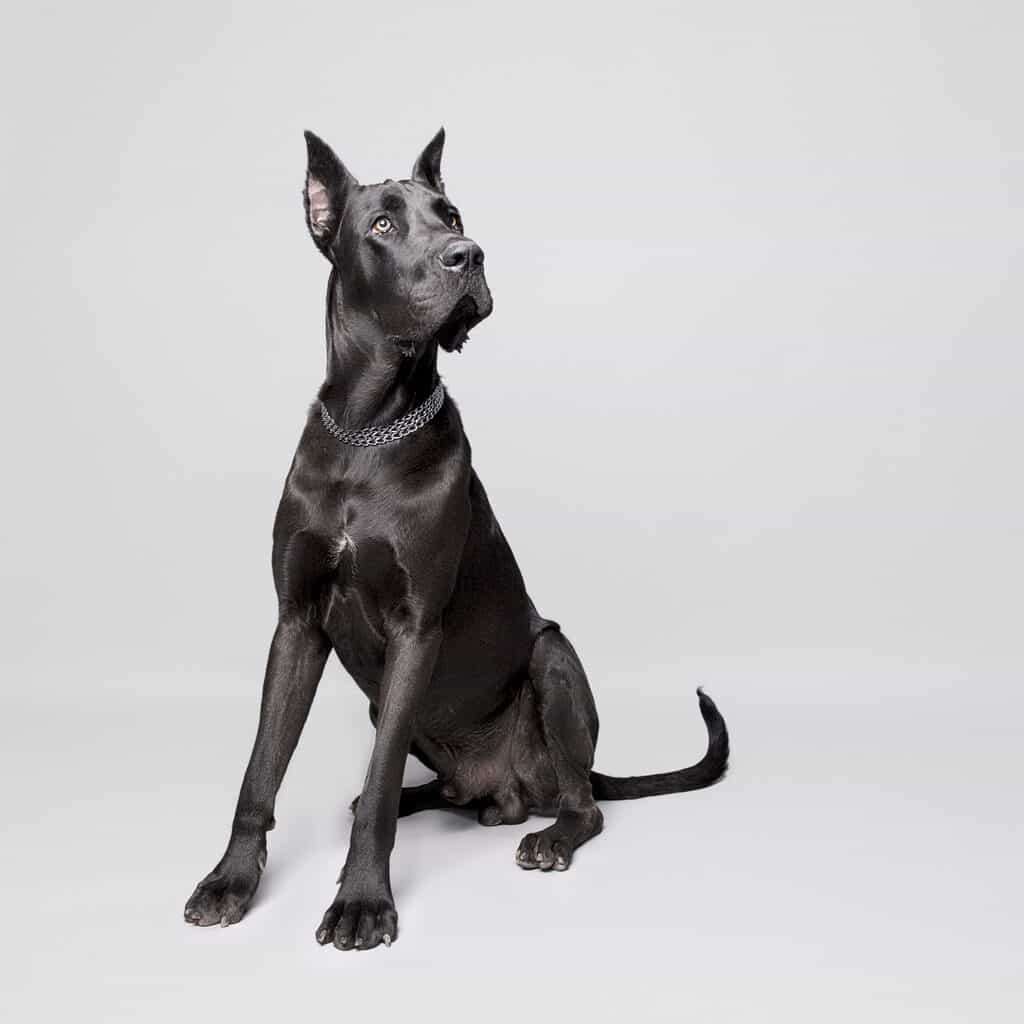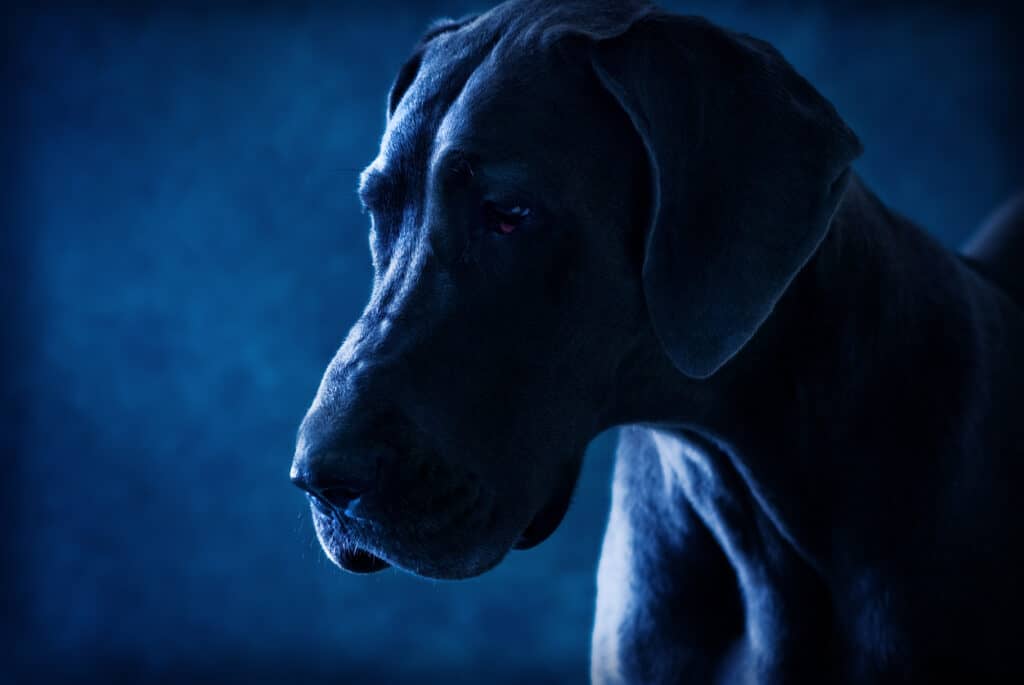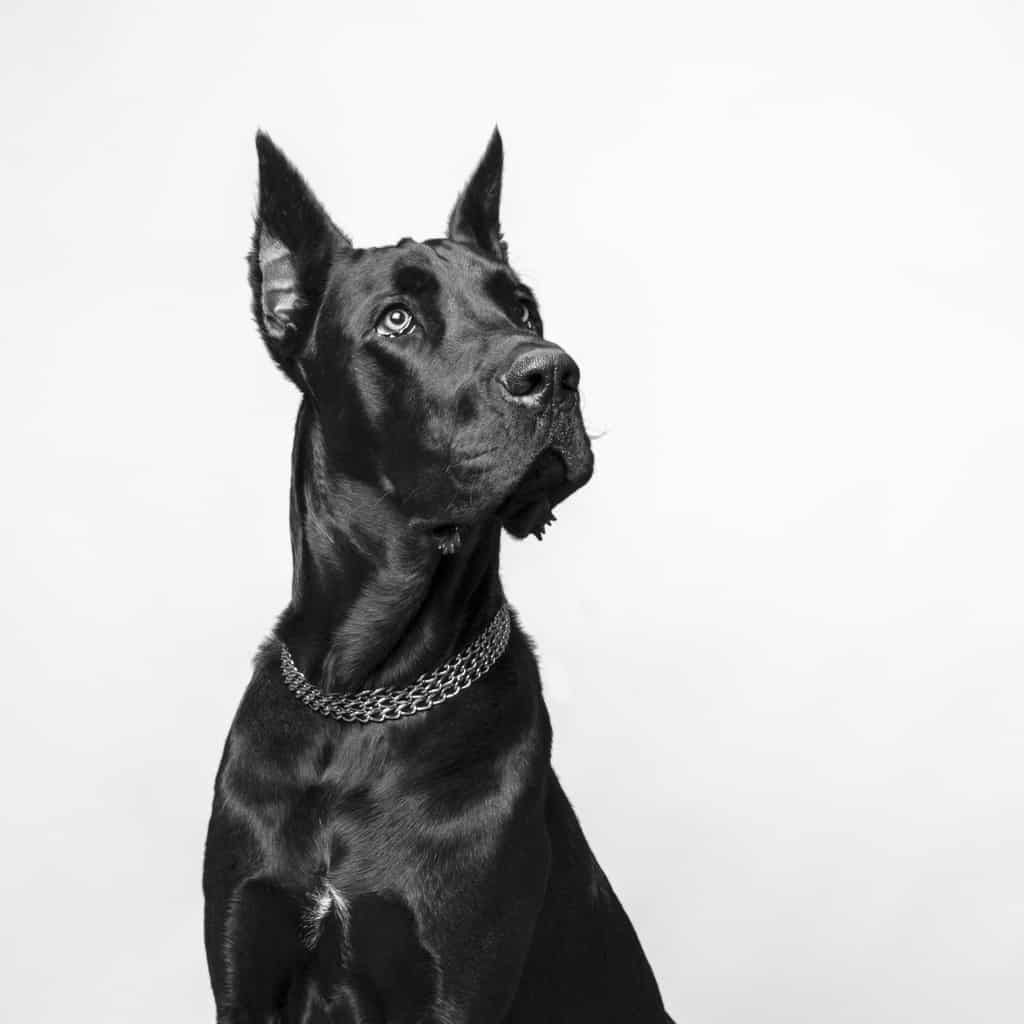Great Danes are one of the most recognizable breeds for their huge size. Regal, powerful, and tall, these former boar catchers herald from the forests of Germany, where their long limbs and superior strength were called upon to assist on boar hunts.

With genetic influences from English Mastiffs and Irish Wolfhounds, Great Danes have short, thick fur that contributes to their overall sleek appearance. However, their look can vary drastically depending on the color of their fur.
Up until recently, the American Kennel Club (AKC) recognized six Great Dane colors: black, blue, brindle, fawn, harlequin, and mantle. On January 1, 2019, they added the color merle to the list of officially recognized colors.
The list of officially recognized Great Dane colors by the AKC serves as a template for breeders and aspiring show dog owners to strive for. In addition to base expectations that the Great Dane’s coat be “short, thick and clearn with a smooth glossy appearance,” the official standard of the AKC also details the color standards. Owners wishing to show their Great Dane should familiarize themselves with this text and convey their intent to their breeder so that the proper puppy can be selected. It’s important to note that just because a Great Dane technically has one of the coats listed as accepted by the AKC, each color is appraised according to a specific list of criteria that your Dane may or may not meet.
Black

Black Great Danes are easy to produce and their coloring makes for an especially imposing-looking companion. While glossy black is beautiful, it can also be hard to maintain due to the color’s natural inclination to become faded over time as a result of exposure to sunlight. Owners who wish to show their black Great Dane should also be aware that any white markings, even small ones on the feet, will not be received favorably in a show ring.
Blue

This steel gray color is eye catching and sleek, particularly when paired with light-colored and gentle eyes. When blue Danes are puppies, they are often mistaken for another German breed, the Weimaraner. This breed was also bred for hunting and shares many characteristics with Great Danes, such as their steady demeanor and occasional stubbornness. However, adult Weimaraners tend to be smaller than Great Danes, with the taller males still being shorter than female Danes.
Brindle
This color seems like it would be difficult to judge due to the mixing of colors happening in the coat. According to the AKC standard, the brindle color should appears as a yellow-gold base “brindled” with black cross stripes that are overlaid on the coat in a chevron pattern. Strong distinction in the marking is ideal, whereas brindles with white markings or weak patterning that creates a dirty-looking appearance are not.
Fawn
One of the most popular and recognizable colors for a Great Dane, this beautiful golden color appears burnished and shines like a polished coin. Black faces are created thanks to a single gene carried by one or both of the parents, and black ears and tail-tips contribute to the overall grand look of Danes bearing this color.
Harlequin
Another color whose quality can be challenging to judge to a beginner is harlequin. A pure-white base is interrupted with mosaic-like black patches that appear, seemingly artfully, over the entirety of the animal’s huge body. Danes bearing this color are often confused with Dalmatians, which have a pure-white base covered in black spots. Like Weimaraners, Dalmatians are typically smaller than even female Danes.
Harlequins also come with some unique health risks that have to do with their genetic makeup, so it’s advisable to conduct background research and consult closely with your breeder to ensure that you are as informed as possible about the background of your desired harlequin puppy.
Mantle
Also known as the “Boston” color because of the way it mirrors the coat of the Boston Terrier, mantles are marked by a black “blanket” over their body, which is interrupted with white on the chest, collar, and muzzle. Unlike some other coat colors, a small white mark in the coat here or there does not disqualify the Dane from meeting the mantle color standard.
Merle
The most recently recognized color in the Great Dane color standard, merle is a coat color with a gray base and black and white spots and patches. This may seem similar to the harlequin – the primary differentiator here is that the base color of the harlequin coat is white, while the base color of a merle coat is gray. That being said, it can sometimes be challenging to tell the base coat color of Great Dane puppies. Like harlequins, there are certain health risks associated with breeding merles, particularly when the pairing is two merles. In this scenario, the likelihood of producing a white Dane increases. White Danes are commonly afflicted with many ailments from birth, and the issues are so pervasive in those bearing the coat color that the AKC has gone so far as to ban the intentional breeding for the color.
There are many other colors of Great Danes. These can manifest as mixes of the officially recognized colors and have no impact on the quality of the Dane, unless you intend to show it. Additionally, many of these mixed-coat colors have fun or cute names, such as merlequin or fawnequin.
While there are many different colors of Great Danes, grooming requirements for their short coats are consistent regardless of whether you have a sleek fawn Dane or an imposing black Dane.
How to groom your Great Dane
Because their coats are short and thick, soft rubber brushes are best for removing dead hair and reducing dander build-up. You can begin grooming your Dane from the time it’s a puppy in order to acclimate it to the feeling of being brushed. This also serves as an important way to socialize and bond with your new gentle giant. Encourage friends and family to take short turns brushing your Great Dane puppy when they visit, so that it can get used to being touched and groomed by different people.
To groom your Great Dane, it’s usually easiest to begin standing. If possible, brush your Dane outside so that you don’t send all their dead hair and dander into your home. If you cannot brush your Dane outside, simply groom them in a sparse corner of your home and be prepared to run the vacuum once you’re done.
To begin, start near their head and gently brush downwards. (If you’ve ever brushed a horse, brushing a dog as big as a Dane will feel similar to that endeavor.) Work your way down their chest, back, ribs, and rear, running the brush under their belly to dislodge any hair that have fallen and gotten caught on the way down. Make sure to get the legs, and you’re all done. You Dane should be relaxed and calm throughout the session, although it may take some tie to teach it to stand patiently while you do both sides!
Another important facet of grooming your Great Dane involves ear care. Because their ears are so large and floppy, they can often acquire quit a bit of buildup that must be removed regularly. Beginning when they’re a puppy, you can include ear care in the routine so that your Dane is not surprised when it’s time to receive a spurt of ear cleaner into its ear canal. This process can be a bit messy, which is why it also helps to do this outside.
Finally, grooming a Great Dane also involves cutting its nails. This can seem daunting if you’re starting with a full-grown Great Dane, so if you have a Great Dane puppy, you want to get them used to this early on. Even though there won’t be much to trim at first, getting them used to the sensation of a small piece of their nails being clipped will make it much easier to engrain in their grooming routine when they’re older, bigger, and more likely to resist being asked to sit quietly while you methodically shorten each of their nails by hand.
Here is a helpful video demonstrating one way of grooming your Great Dane.
Of course, you can always take your Great Dane to the groomer, but this choice comes with some points to consider. Great Danes are highly at risk of developing bloat throughout their lives. Bloat is a serious, painful, and often life-threatening stomach condition that is often triggered by stress. For many dogs, going to the groomer can be a stressful event, so if you’re planning to outsource your Great Dane’s grooming, approaching the outing like a socialization event full of positive reinforcements is crucial.
There are benefits to paying for a groomer in addition to relieving yourself of the time and energy – groomers can also provide insight and recommendations into hair care for your Great Dane. This is helpful because Danes can suffer from skin allergies, resulting in heavy skin shedding and a lowered coat quality. A regular groomer will both be aware of what your Dane’s coat and skin look like normally and will be able to advise should any abnormalities develop relating to the scope of their grooming expertise.
Although Great Danes have short coats, they are not hypoallergenic. They are considered moderate shedders and shed their single coat once a year, typically in the spring. Throughout the rest of the year, one to two maintenance grooming sessions a week is typically sufficient to keep their short fur healthy.
A healthy Great Dane’s coat should be short, thick, and glossy, regardless of the color. Excessive shedding out of season may signal an underlying medical problem, so if you notice that your Great Dane is losing hair at a higher rate than usual, it may be time to make an appointment with your veterinarian to determine why.
There are a variety of factors that can lead to increased shedding in Danes, ranging from old age to a lack of vitamins to a nutritional deficiency, or something else. Having a base knowledge of what their short, thick fur should look like will help you ascertain if there are any problems with your Dane’s help and can also provide a useful reference point if there is a health problem to monitor and treat.
Great Danes make wonderful family pets and are not especially high maintenance when it comes to their fur, however their size does implicate them in the amount of time it takes to groom them and maintain their general hygiene. Prospective owners should consider their previous experience grooming dogs and bear in mind that Great Danes require slightly more specialized attention than a simple bi-weekly brushing.


